Related Research Articles

Ascomycota is a phylum of the kingdom Fungi that, together with the Basidiomycota, forms the subkingdom Dikarya. Its members are commonly known as the sac fungi or ascomycetes. It is the largest phylum of Fungi, with over 64,000 species. The defining feature of this fungal group is the "ascus", a microscopic sexual structure in which nonmotile spores, called ascospores, are formed. However, some species of Ascomycota are asexual and thus do not form asci or ascospores. Familiar examples of sac fungi include morels, truffles, brewers' and bakers' yeast, dead man's fingers, and cup fungi. The fungal symbionts in the majority of lichens such as Cladonia belong to the Ascomycota.
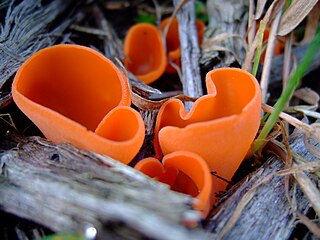
Pezizomycotina make up most of the Ascomycota fungi and include most lichenized fungi too. Pezizomycotina contains the filamentous ascomycetes and is a subdivision of the Ascomycota'. It is more or less synonymous with the older taxon Euascomycota. These fungi reproduce by fission rather than budding and this subdivision includes almost all the ascus fungi that have fruiting bodies visible to the naked eye.

Eurotiomycetes is a large class of ascomycetes with cleistothecial ascocarps within the subphylum Pezizomycotina, currently containing around 3810 species according to the Catalogue of Life. It is the third largest lichenized class, with more than 1200 lichen species that are mostly bitunicate in the formation of asci. It contains most of the fungi previously known morphologically as "Plectomycetes".

Sordariomycetes is a class of fungi in the subdivision Pezizomycotina (Ascomycota). It is the second-largest class of Ascomycota, with a worldwide distribution that mostly accommodates terrestrial based taxa, although several can also be found in aquatic habitats. Some are phytopathogens that can cause leaf, stem, and root diseases in a wide variety of hosts, while other genera can cause diseases in arthropods and mammals.
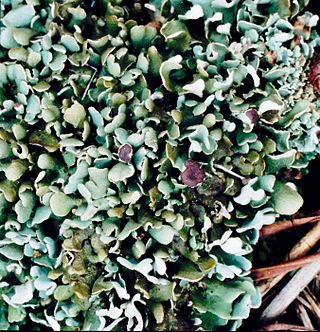
Lecanoromycetes is the largest class of lichenized fungi. It belongs to the subphylum Pezizomycotina in the phylum Ascomycota. The asci of the Lecanoromycetes most often release spores by rostrate dehiscence.

Dikarya is a subkingdom of Fungi that includes the divisions Ascomycota and Basidiomycota, both of which in general produce dikaryons, may be filamentous or unicellular, but are always without flagella. The Dikarya are most of the so-called "higher fungi", but also include many anamorphic species that would have been classified as molds in historical literature. Phylogenetically the two divisions regularly group together. In a 1998 publication, Thomas Cavalier-Smith referred to this group as the Neomycota.
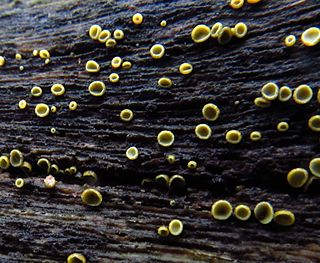
The Dermateaceae is a family of cup fungi in the order Helotiales. Most species in this family are plant pathogens but some are saprobes. These fungi are commonly referred to as "earth tongues" or "earthfan fungi" due to their distinctive appearance.

Peltigerales is an order of lichen-forming fungi belonging to the class Lecanoromycetes in the division Ascomycota. The taxonomy of the group has seen numerous changes; it was formerly often treated as a suborder of the order Lecanorales. It contains two suborders, eight families and about 45 genera such as Lobaria and Peltigera.

The Lecanorales are an order of mostly lichen-forming fungi belonging to the class Lecanoromycetes in the division Ascomycota. The order contains 26 families, 269 genera, and 5695 species.
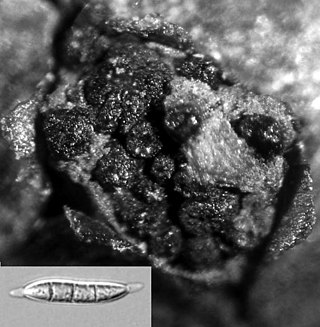
The Melanconidaceae are a family of fungi in the order Diaporthales, class Sordariomycetes.
The Microthyriaceae are a family of fungi with an uncertain taxonomic placement in the class Dothideomycetes.
The Parmulariaceae are a family of fungi with an uncertain taxonomic placement in the class Dothideomycetes.
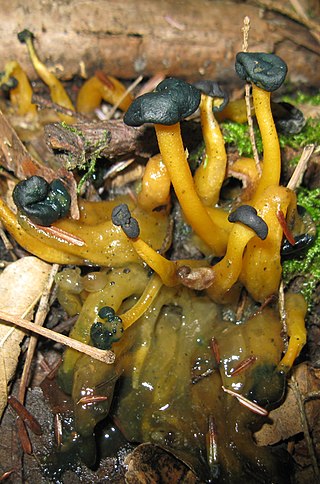
Leotiomyceta represents all the filamentous ascomycete fungi (Pezizomycotina), excluding the classes Pezizomycetes and Orbiliomycetes. It is well supported in several studies comparing DNA sequences in fungi. It has originally been proposed as a superclass but later was proposed as a rankless taxon for any well supported group above class. Rankless taxa do not strictly follow the rules for taxonomic classifications in plants and fungi (ICBN) and therefore these names are informal, although they appear to reflect natural groups.
Phylloporina is a genus of fungi in the Ascomycota phylum. The relationship of this taxon to other taxa within the phylum is unknown, and it has not yet been placed with certainty into any class, order, or family.

The Rhytismatales are an order of the class Leotiomycetes within the phylum Ascomycota.

The Thelebolales are an order of the class Leotiomycetes within the division Ascomycota. It contains the single family Thelebolaceae, circumscribed in 1968 by Finnish mycologist Finn-Egil Eckblad.

The Umbilicariales are an order of lichenized fungi in the subclass Umbilicariomycetidae, class Lecanoromycetes. It contains five families: Elixiaceae, Fuscideaceae, Ophioparmaceae, Ropalosporaceae, and Umbilicariaceae. Umbilicariales was proposed as a new order in 2007, while the subclass Umbilicariomycetidae was proposed in 2013.

The Lasiosphaeriaceae are a family of fungi in the Ascomycota, class Sordariomycetes.
The Gymnoascaceae are a family of fungi in the Ascomycota, class Eurotiomycetes.
References
- ↑ Lumbsch TH, Huhndorf SM. (December 2007). "Outline of Ascomycota – 2007". Myconet. 13. Chicago, USA: The Field Museum, Department of Botany: 1–58. Archived from the original on 2009-03-18.